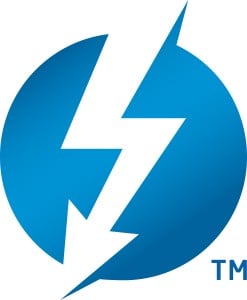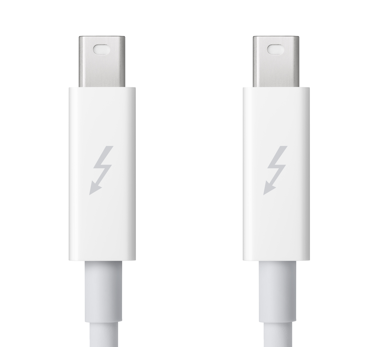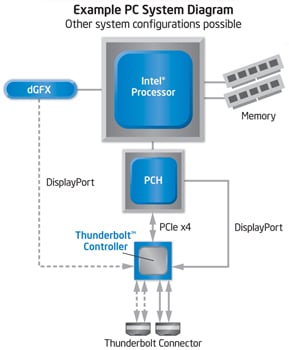- HubPages»
- Technology»
- Computers & Software»
- Computer How-Tos & Tutorials
Thunderbolt - Apple's New Interface - How Does it Work
About Thunderbolt
Intel has been working on this new interface for quite some time, but it was officially introduced in 2009 at the Intel Developer Forum. The interface boasts a ten gigabit per/second transfer rate and may well be Intel's answer to all past data transfer schemes including, but not limited to USB, PCI Express, DisplayPort and even Ethernet.
Because Thunderbolt is bi-directional is can move data to or from any Thunderbolt compatible device to another. It can also transfer data t DisplayPort and PCI Express enabled equipment.
With ten gigabit per second performance Intel claims that a computer equipped with this interface can:
- Transfer a full-length HD movie in less than 30 seconds
- Backup 1 year of continuous MP3 playback in just over 10 minutes


Originally Called Light Peak
Intel's code name for the project as Light Peak and it has been brought to marked through Apple Incorporated on the new MacBook Pro (2011). Thunderbolt supports two existing, older technologies in the form of DisplayPort and PCI Express. Thunderbolt has the following features:
- Dual-channel 10 Gbps per port
- Bi-directional
- Dual-protocol (PCI Express* and DisplayPort*)
- Compatible with existing DisplayPort devices
- Daisy-chained devices
- Electrical or optical cables
- Low latency with highly accurate time synchronization
- Uses native protocol software drivers
- Power over cable for bus-powered devices
Thunderbolt is designed to interconnect PCs and other devices. It can transmit and receive packeted data traffic under both PCI and DisplayPort protocols. In this way Thunderbolt seems more like a bus than a data interface.
Plans to support Thunderbolt are already in the works with not just Apple, but Aja, Apogee, Avid, Blackmagic, LaCie, Promise and Western Digital.
Aja make video signal converter hardware.
Avid makes music oriented hardware such as recorders, editors, and consoles. Blackmagic makes video recording and editing hardware.
LaCie makes data storage devices.
Promise makes RAID (Random Array of Independent Disc) storage devices for Promise the thunderbolt interface will be incorporated into hardware designed to support media and entertainment customers.
Finally Western Digital makes fixed disc storage systems.


How Does it Work
Light Peak was originally introduced by Intel as an optical technology, using infrared light and receivers to transmit data at high rates of speed. Since the introduction in 2009 Intel has fallen back to a copper wire based transmission system. One advantage with copper wire is the ability to transmit power as well as data.
Thuderbolt is said to be able to transfer up to ten Watts (10W) of power over its wired connection. For comparison USB 2.0 & 3.0 carry five Watts.
The Tech Inside
This Thunderbolt transceiver has two tiny light emitting lasers (Vertical Cavity Surface Emitting Lasers [VCSELs]) and two tiny photo detectors built in. The lasers are the width of two human hairs placed side-by-side. They can transmit light over each (of the two) channels using fiber-optic cable one hundred twenty-five (125) microns wide. The photo detectors receive the light from the other end and circuitry within the Thunderbolt interface converts those to electrical (wired) signals.
Protocols
A controller chip within the interface can switch the data into two supported protocols (DisplayPort and PCI Express). Both signal types can be run over a single Thunderbolt cable (see image right). This means many devices sharing either protocol can be supported on a single Thunderbolt cable. This, in turn, means that smaller and more efficient components and devices can be built using this interface.
Long Distance Transmission
Completely optical Thunderbolt cables could run up to three hundred twenty-eight (328') feet or one hundred (100M) meters. Today's USB cables can run no more than about sixteen (16') feet or five meters.
Coda
Intel's new Thunderbolt interface has a lot of promise. The ten gigabit standard of today's Thunderbolt is just the "tip-of-the-iceberg" in data-speed; Intel states that it plans speeds of up to one hundred gigabits per second.
To put that into perspective that would be a full length two hour movie transmitted in just under a five seconds. With speeds like this it is conceivable that the new interface could replace wired connections for intranet connectivity in office settings, as a "go to" technology in high speed video recording and improved music recording and editing interfaces.
The possibilities seem limitless or at least far less limited than before.
Note that as of this writing Thunderbolt can only daisy-chain up to six devices; FireWire can support up to sixty-three (63). This is not such good news.
Disclaimer
The author was not compensated in any way, monetarily, with discounts, or freebies by any of the companies mentioned.
Though the author does make a small profit for the word count of this article none of that comes directly from the manufacturers mentioned. The author also stands to make a small profit from advertising attached to this article.
The author has no control over either the advertising or the contents of those ads.





